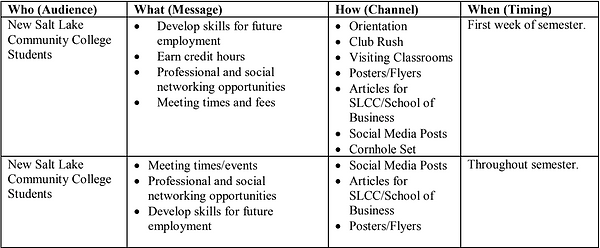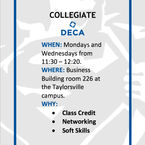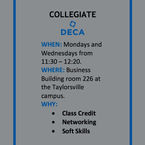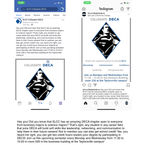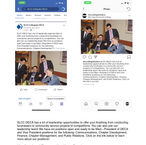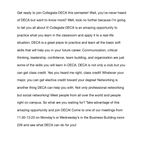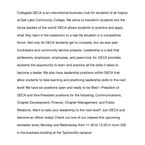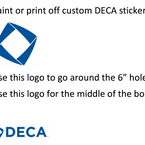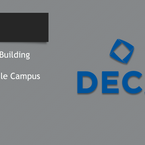Business Communications DECA Recruiting Campaign
Strategic Communications Plan for DECA Recruiting
McKenzie Ball, Hunter Mattson, Manjit Toor, Skyler Trujillo
Salt Lake Community College
BUS-2200
12/5/2018
Lon Schiffbauer
Purpose/Objective
The purpose of this communications campaign is to encourage Salt Lake Community
College students to join DECA. It is our hope that Salt Lake Community College students will
join DECA early in their academic career to gain necessary work skills. After graduating,
students may be nervous about starting their careers and knowing if they have the necessary
skills to be successful. Joining DECA allows students to apply what they learn in the classroom
to real-world situations. DECA also provides strong leadership skills and a good understanding
of soft skills needed in the workplace. In addition, DECA provides students with opportunities to
network with successful people around the world. This campaign will take place at the beginning
of the semester and will be covered across the Taylorsville campus. We will accomplish this by
using a variety of channels.
Audience
The target audience for this communications campaign is mainly Salt Lake Community
College students newly enrolled or early in their academic career but not limited to just these. All
students are encouraged to join DECA. Below are the demographics and psychographics of the
target audience:
Demographics
• Median age of Salt Lake Community College Students:
o 23 (Salt Lake Community College, 2018)
• Non-white Population at Salt Lake Community College:
o 26.3% (Salt Lake Community College, 2018)
• Female to Male Ratio at Salt Lake Community College
o 1.04:1 (Salt Lake Community College, 2018)
• Student Enrollment for the 2017-18 year is 29,620. Below represents specific
majors typically interested in DECA. (Salt Lake Community College, 2018)
o General Studies Major: 13,294
o Accounting Major: 205
o Business Major: 1,784
o Economics Major: 61
o Bus Mgt/Entrepreneur Major: 291
• Average Credit Hours Taken for the 2017-18 Fall Semester:
o 8.68 hours (Salt Lake Community College, 2018)
• First Time Freshmen enrolled for the 2017-18 Fall Semester:
o 4,626 (Salt Lake Community College, 2018)
• 78.79% of students for the 2017-18 Fall Semester live within Salt Lake County.
(Salt Lake Community College, 2018)
Psychographics
• Students are attracted to community colleges because of the affordability, flexible
schedule, and transferable credits. (Salt Lake Community College, 2018)
• Students attend college to better their future, and further their formal education.
(Salt Lake Community College, 2018)
• Students who join DECA are generally gravitating towards careers in
entrepreneurship, marketing, finance, or management.
• Greater development is possible for community college students when
participating in clubs and organizations. (Foubert, 2006)
Context
The context surrounding this communications campaign include;
• The beginning of a new semester.
• Students may feel stressed trying to get use to the new semester.
• Students may be looking for new opportunities.
• Students may feel they do not have time for extra-curricular activities.
• New students on campus for their first college experience.
Audience Analysis
The target audience for this campaign is new and incoming students at Salt Lake
Community College. According to the demographics, many students are enrolled for
general studies and may be unsure of future career paths. Incoming students may also not
know many people on campus which may be intimidating. DECA can give students
direction and provide them with skills that will benefit them throughout their academic
career as well as their professional career. Students who join clubs early in their academic
career receive guidance and form lasting relationships that they can benefit them. DECA
provides students with a fun and unique opportunity to receive credits for their degree.
Messaging Goals
Based on the purpose and objectives, as well as the target audience, the following have
been established as the messaging goals for this campaign:
Think
• Know the benefits and opportunities that come from joining DECA.
• DECA meets Monday and Wednesday mornings from 11:30-12:20.
• It is a club you can receive credit for.
• There is a $30 fee.
Feel
• Students will feel more confident taking other courses and completing coursework
because of the things they have learned in DECA.
• Students will feel more capable of making new friends and building relationships.
• DECA will help students for years to come after graduation.
Do
• Join DECA.
• Be engaged in DECA and actively participate.
Key Messages
If the target audience does not remember anything else from this communication
campaign, these are the three things we hope they retain:
• DECA is a great way to provide students the necessary skills that will allow them to stand
out from other people in the workplace and excel within their career.
• Unlike other clubs, students who enroll in DECA will earn credit hours for joining and
participating.
• DECA provides students with professional and social networking opportunities which
can lead to new friendships and employment opportunities.
Channels/Media
We have constructed primary and secondary channels to reach our audience. In
conducting our primary and secondary channels we have taken into consideration the purpose of
our message, our primary audience, and how our audience consumes information. The following
are our primary and secondary channels/media.
• Club Rush (Primary)
o Club rush is an event that SLCC puts on for students to get to know what
clubs and organizations are available for them. Each club is given a table
to represent their club and its information to get students to join.
o We will be making a tri-fold with information about DECA and what
DECA is. We also will create a game to draw in attention of the students
at the event.
• Orientation (Primary)
o SLCC orientation is an event put on for new incoming students, so they
can learn more about SLCC and its clubs/organization.
o We will make a short PowerPoint that will be shown at orientation for new
incoming students to know what DECA is and why they should join.
• Visiting classrooms (Primary)
o Many students around campus don’t know about DECA because they just
go to class and go home. We want to visit classrooms around campus so
those who don’t spend much time at campus to know about DECA.
o We will create little flyers with information about DECA to hand out in
the classrooms we visit.
• Flyers (Secondary)
o Flyers are a good way to put information about DECA everywhere on
campus. We plan on putting flyers up anywhere we can promote DECA
and why you should join.
o We plan on making flyers to put around campus.
• Social Media Posts (Secondary)
o We live in a generation where social media plays a big role in our
everyday lives. We want to have social media posts ready that can be used
throughout the semester to promote DECA and explain why one should
join.
o We will create posts for the beginning of the semester as well as post for
certain events throughout the semester.
• Articles for SLCC/School of Business (Secondary)
o SLCC newspaper and the School of Business newspaper is always posting
articles about clubs and organizations around campus. This is a great way
to get the word about DECA and what it is.
o We will create two articles promoting DECA that can be published in the
beginning of the semester.
• Cornhole Set (Secondary)
o At club rush activities, some tables have games or a wheel to spin to
attract people to visit the table. This allows for the people managing the
table to start a conversation and answer any questions the people visiting
may have.
o We will gather the information of how to create a cornhole set with a
possible design that may be painted onto the boards.
Tactical Planning
To make sure the target audience receives this information when it is most pertinent to
them, this tactical plan has been created to show when and how the campaign messages will be
shared:
Debrief
Throughout the campaign, everyone in the team participated and was engaged. The team
was able to communicate effectively, offer opinions and suggestions openly, and come to a
conclusion on what would be best for the campaign. The biggest challenge we faced was being
able to meet due to everyone’s busy schedule and commitments for other projects. We feel the
channels that were used were fitting for the audience we were trying to reach. Although some
channels will be more effective than others, we feel that having a cohesiveness among all the
channels will make people more likely to remember the key messages when they see the DECA
logo, colors, or anything associated with DECA in the future. The biggest lesson we learned is
that there are many ways to communicate. To add to that, there are many good ways, and many
bad ways to communicate as well. It all depends upon the purpose and audience.
Conclusion
Students who join DECA will gain greater workplace skills, receive credit for their
desired degree, and will develop a beneficial network. With all these things combined, students
will be more successful in their future.
Reflection
This Strategic Communications Plan and Final Communications Campaign taught me a lot about communication, teamwork, strategical thinking, critical thinking, organization, time management, audience analysis, and technical planning. This project overall allowed me to apply what I learned in business communications 2200 into a real life situation. I loved working on this project because it had to do with DECA. Being the VP of Public Relations in DECA, I liked having the opportunity to work on DECA recruiting. I have wanted to come up with something new for club rush and orientation, this class and team gave me that opportunity. Overall, I loved working on this project with my team.
References
About deca. (2018). Retrieved November 14, 2018, from https://www.deca.org/about/
John D. Foubert Ph.D. & Lauren A. Urbanski (2006) Effects of Involvement in Clubs and
Organizations on the Psychosocial Development of First-Year and Senior College
Students, NASPA Journal, 43:1, 166-182, DOI: 10.2202/1949-6605.1576
Salt Lake Community College Factbook (2017-2018). Retrieved November 14, 2018, from
http://performance.slcc.edu/Factbook/2017-18/A_enrollment/A_04.html
SLCC (2018). Retrieved November 14, 2018, from http://www.slcc.edu/
